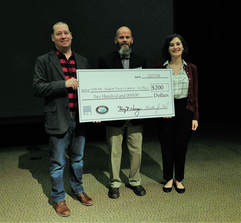 Congratulations, Julianna Greenberg (Biological Sciences Undergrad, Palmer Lab) for winning first place in the Student Poster Competition at the Maryland Water Monitoring Council’s Annual Meeting. Julianna’s winning poster, " Evaluating the effects of system maturation on pollutant loads from stream-wetland complexes”, is on display in the hallway outside of room 4129. Abstract: Throughout the world many streams and rivers are highly degraded and scientists are working to understand when and why certain restoration efforts result in improvements and others don’t. This study focused on small urban streams in the Chesapeake Bay watershed that were slated for restoration in order to reduce the movement of excess nutrients and sediments toward Bay Waters. Church and Cypress creeks were degraded urban streams located in Anne Arundel County. These were converted to stream-wetland complexes (SWCs) that include engineered wetlands and step-pool conveyances extending to the estuarine interface. Monitoring occurred throughout the pre- and post-construction phases to estimate the changes in catchment loads of nitrogen (N), phosphorous (P), and total suspended solids (TSS) from the outflow of the restored stream reaches. Results indicate that moderate reductions in N loads and increases in TSS and P occurred since SWC implementation in Church Creek. The study authors concluded that the increases in TSS and P were due to extensive and more recent headwater restoration activities. By contrast, Cypress Creek had no recent disturbances in its headwaters and results indicate that water quality (e.g., TSS and P) has improved with system maturation. This improvement implies that shorter-term restoration studies that do not capture the maturation process may underestimate the true long-term performance of SWCs for some constituents. Comments are closed.
|
Categories
All
Archives
June 2024
|
Department of Entomology
University of Maryland
4112 Plant Sciences Building
College Park, MD 20742-4454
USA
Telephone: 301.405.3911
Fax: 301.314.9290
University of Maryland
4112 Plant Sciences Building
College Park, MD 20742-4454
USA
Telephone: 301.405.3911
Fax: 301.314.9290

 RSS Feed
RSS Feed




